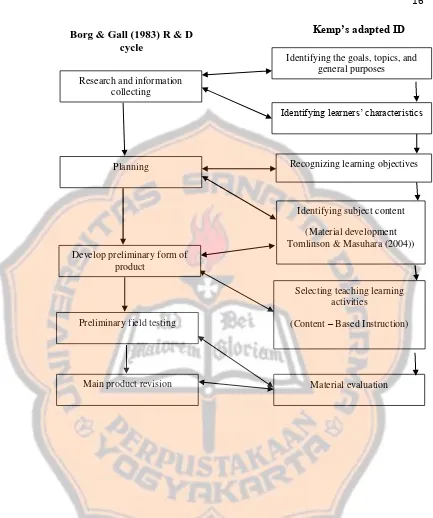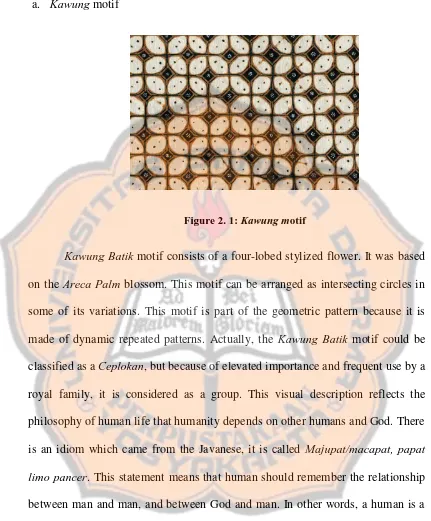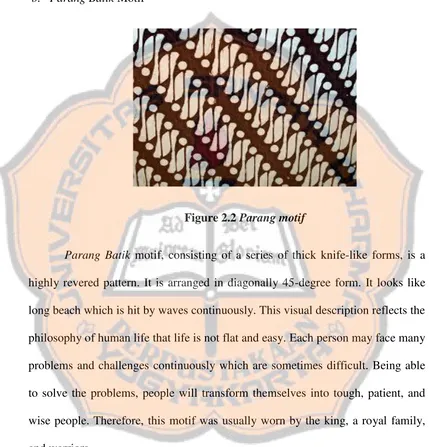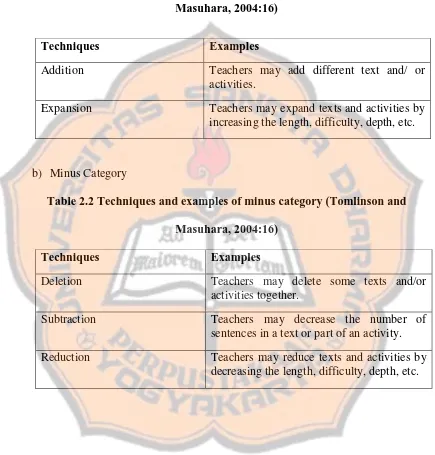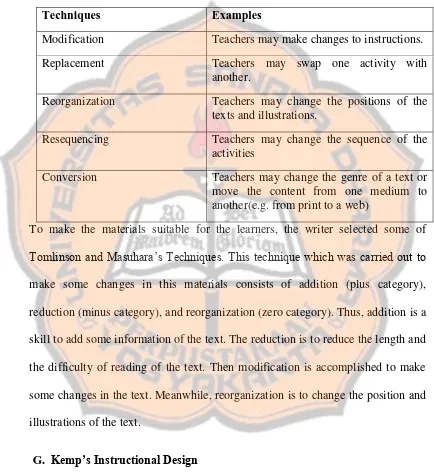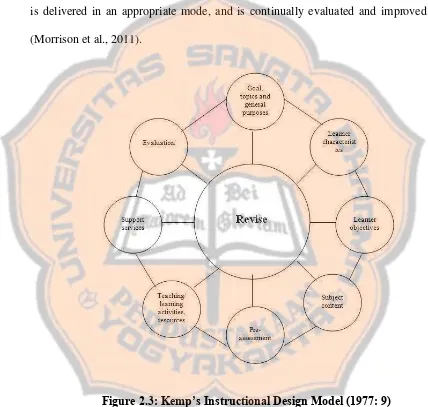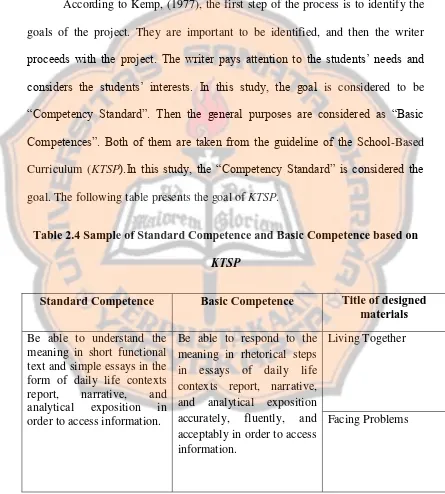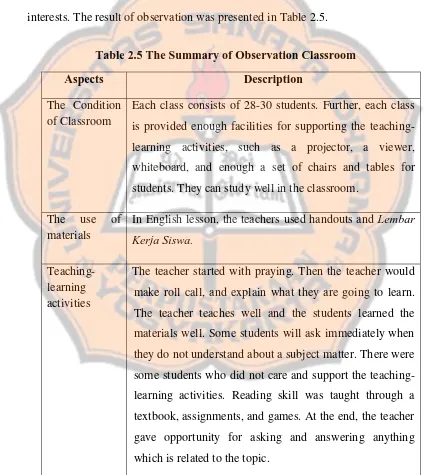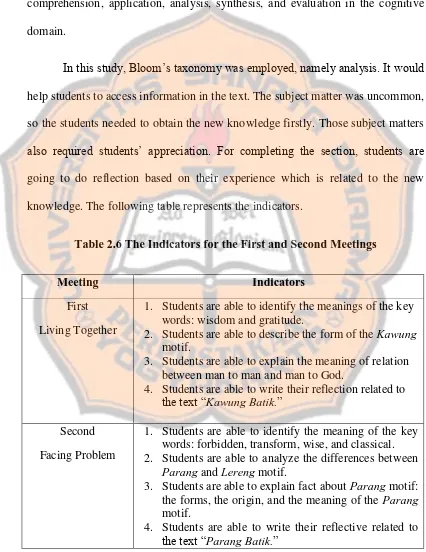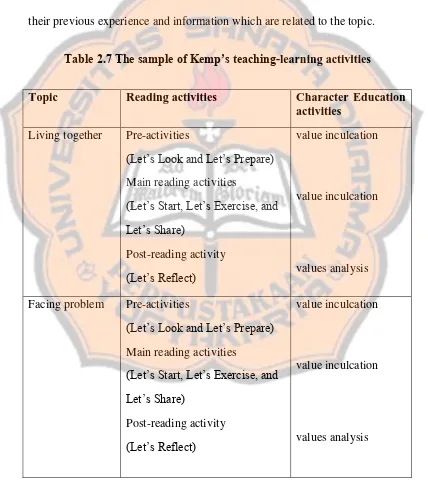ABSTRACT
Sudibyo, Satrio Pambudi. (2016). Designing A Set of Supplementary Reading Materials to Introduce the Philosophy of Batik to Senior High School Students. Yogyakarta: English Language Education Study Program Sanata Dharma University.
Reading is one of the language skills taught to senior high school students. However, the students might not always be interested in their reading activities due to uninteresting reading materials. In order to provide the variation of reading materials, the writer decided to design supplementary reading materials. Batik was selected as the theme topic of the designed materials, since it had been recognized by UNESCO as one of Indonesia’s cultural heritage. Batik had so many motif which carried the philosophy of human life. Furthermore, this philosophy was needed to develop the student’s character.
This study objective is to design a set of supplementary reading materials to introduce the philosophy of Batik to senior high school students. The writer formulates one research problem in this research, namely, how is a set of supplementary reading materials to introduce the philosophy of Batik to senior high school students designed?
In order to answer the resarch problem, the writer adapted Borg & Gall’s theory (1983) for the method of Research and Development (R&D) and Kemp’s instructional design theory (1977). Despite the ten steps, the writer only employed five steps. The steps undertaken were: (1) research and information collecting, (2) planning, (3) develop preliminary form of product, (4) preliminary field testing, and (5) final product revision. The writer employed six steps of Kemp’s instructional design theory to develop this designed materials. The six steps were (1) identifying the goals, topics, and general purposes, (2) identifying learner’s characteristics, (3) recognizing learning objectives, (4) identifying subject content, (5) selecting teaching-learning activities, and (6) materials evaluation and revision. All of those steps were linked to R&D steps. In addition, the writer also employed some principles of the Content-Based Instruction (CBI) and the theories of the material development by Tomlinson & Masuhara (2004) to design supplementary reading materials. The result of the evaluation questionnaire indicated that the designed materials were good and acceptable but needed some revisions.
Finally, the writer presented the revised set of supplementary reading materials. There were two units presented in this study. The units had six parts, namely, Let’s Look, Let’s Prepare, Let’s Start, Let’s Exercise, Let’s Share, and Let’s Reflect which functioned as pre-reading, main, and post-reading activities. Tthe writer hopes these designed materials can help senior high school teachers to introduce the philosophy of Batik as part of character education.
ABSTRAK
Sudibyo, Satrio Pambudi. (2016). Designing A Set of Supplementary Reading Materials to Introduce the Philosophy of Batik to Senior High School Students. Yogyakarta: English Language Education Study Program Sanata Dharma University.
Membaca merupakan salah satu kemampuan berbahasa yang diajarkan kepada siswa – siswa SMA. Meskipun demikian, siswa – siswa itu mungkin tidak selalu tertarik pada kegiatan membaca karena materi bacaan yang tidak menarik. Untuk dapat menyediakan tambahan variasi materi, penulis memutuskan untuk merancang tambahan bahan ajar membaca. Batik dipilih sebagai tema dari rancangan materi – materi tersebut, sebab Batik sudah diakui oleh UNESCO sebagai salah satu warisan budaya dari Indonesia. Batik memiliki beragam motif yang mengandung filosofi kehidupan manusia. Terlebih lagi, filosofi ini dibutuhkan untuk mengembangkan karakter siswa.
Tujuan dari studi ini adalah untuk merancang seperangkat materi membaca tambahan guna mengenalkan filosofi Batik kepada siswa - siswa SMA. Penulis menyusun sebuah permasalahan di dalam penelitian ini yakni: bagaimana seperangkat materi tambahan membaca untuk mengenalkan filosofi Batik kepada siswa - siswi SMA dirancang?
Untuk menjawab permasalahan ini, penulis mengadaptasi teori desain bahan ajar milik Kemp (1977), teori penelitian dan pengembangan milik Borg & Gall (1983) sebagai metodenya. Meskipun ada sepuluh langkah, penulis hanya menggunakan lima langkah. Kelima langkah adalah sebagai berikut penelitian dan (1) pengumpulan informasi, (2) perencanaan, (3) pengembangan produk awal, (4)uji coba awal, dan (5) revisi produk siap pakai. Penulis melaksanakan enam langkah teori desain bahan ajar milik Kemp untuk mengembangkan rancangan materi ini. Enam langkah itu ialah (1) mengidentifikasi tujuan, topik , dan tujuan umum, (2) mengidentifikasi karakteristik siswa, (3) menjabarkan tujuan pembelajaran, (4) mengidentifikasi isi bahan ajar, (5) memilih kegiatan belajar mengajar, dan (6) evaluasi dan revisi materi. Semua langkah tersebut terhubung dengan siklus penelitian dan pengembangan. Sebagai tambahan, penulis menggunakan beberapa prinsip dari Content-Based Instruction (CBI), dan teori materi pengembangan materi oleh Tomlinson & Masuhara (2004) untuk mendisain tambahan materi membaca. Hasil dari evaluasi menunjukkan bahwa rancangan materi baik dan dapat diterima namunmasih membutuhkan beberapa perbaikan.
Akhir kata, penulis menyediakan seperangkat materi membaca yang telah diperbaiki. Ada dua unit yang tersedia di dalam studi ini. Dalam satu unit terdapat enam bagian, yakni Let’s Look, Let’s Prepare, Let’s Start, Let’s Exercise, Let’s Share,dan Let’s Reflect yang berfungsi sebagai proses pra-membaca, kegiatan utama, dan kegiatan pasca membaca. Dengan rancangan materi ini, penulis berharap materi- matari membaca ini dapat membantu guru- guru SMA untuk mengenalkan filosofi Batik sebagai bagian dari pendidikan.
DESIGNING A SET OF SUPPLEMENTARY READING
MATERIALS TO INTRODUCE THE PHILOSOPHY OF BATIK
TO SENIOR HIGH SCHOOL STUDENTS
A Sarjana Pendidikan Final Paper
Presented as Partial Fulfillment of the Requirements to Obtain the Sarjana Pendidikan Degree
in English Language Education
By
Satrio Pambudi Sudibyo Student Number: 101214172
ENGLISH LANGUAGE EDUCATION STUDY PROGRAM
DEPARTMENT OF LANGUAGE AND ARTS EDUCATION
FACULTY OF TEACHERS TRAINING AND EDUCATION
SANATA DHARMA UNIVERSITY
YOGYAKARTA
i
DESIGNING A SET OF SUPPLEMENTARY READING
MATERIALS TO INTRODUCE THE PHILOSOPHY OF BATIK
TO SENIOR HIGH SCHOOL STUDENTS
A Sarjana Pendidikan Final Paper
Presented as Partial Fulfillment of the Requirements to Obtain the Sarjana Pendidikan Degree
in English Language Education
By
Satrio Pambudi Sudibyo Student Number: 101214172
ENGLISH LANGUAGE EDUCATION STUDY PROGRAM
DEPARTMENT OF LANGUAGE AND ARTS EDUCATION
FACULTY OF TEACHERS TRAINING AND EDUCATION
SANATA DHARMA UNIVERSITY
YOGYAKARTA
ii
A Sarjana Pendidikan Final Paper on
DESIGNING A SET OF SUPPLEMENTARY READING
MATERIALS TO INTRODUCE THE PHILOSOPHY OF BATIK
TO SENIOR HIGH SCHOOL STUDENTS
By
Satrio Pambudi Sudibyo Student Number: 101214172
Approved by
Advisor
Date:
iii
A Sarjana Pendidikan Final Paper on
DESIGNING A SET OF SUPPLEMENTARY READING
MATERIALS TO INTRODUCE PHILOSOPHY OF BATIK TO
SENIOR HIGH SCHOOL STUDENTS
By
Satrio Pambudi Sudibyo Student Number: 101214172
Defended before the Board of Examiners On 3 May 2016
and Declared Acceptable
Board of Examiners
Chairperson : Paulus Kuswandono, Ph.D. __________________ Secretary : Ch. Lhaksmita Anandari, S.Pd., Ed.M. __________________ Member : Dr. Retno Muljani, M.Pd. __________________ Member : G. Punto Aji, S.Pd., M.Hum. __________________ Member : Ch. Lhaksmita Anandari, S.Pd., Ed.M. __________________
Yogyakarta, 3 May 2016
Faculty of Teachers Training and Education Sanata Dharma University
Dean,
iv
PAGE OF DEDICATION
v
STATEMENT OF WORK’S ORIGINALITY
I honesty declare that this final paper, which I have written, does not contain the work or parts of the work of other people, except those cited in the questions and the references, as a scientific paper should.
Yogyakarta, 15 April 2016 The Writer
vi
LEMBAR PERNYATAAN PERSETUJUAN
PUBLIKASI KARYA ILMIAH UNTUK KEPENTINGAN AKADEMIS
Yang bertanda tangan dibawah ini, saya mahasiswa Universitas Sanata Dharma:
Nama : Satrio Pambudi Sudibyo
Nomor Mahasiswa : 101214172
Demi pengembangan ilmu pengetahuan, saya memberikan kepada Perpustakaan Universitas Sanata Dharma karya ilmiah saya yang berjudul:
DESIGNING A SET OF SUPPLEMENTARY READING
MATERIALS TO INTRODUCE PHILOSOPHY OF BATIK TO
SENIOR HIGH SCHOOL STUDENTS
Beserta perangakat yang diperlukan (bila ada). Dengan demikian saya memberikan kepada Perpustakaan Universitas Sanata Dharma hak untuk menyimpan, mengalihkan dalam bentuk media lain, mengelolanya dalam bentuk pangkalan data, mendistribusikan secara terbatas, dan mempublikasikannya di internet atau media lain untuk kepentingan akademis tanpa perlu meminta ijin dari saya maupun memberikan royalti kepada saya selama tetap mencantumkan nama saya sebagai penulis.
Demikian pernyataan ini yang saya buat dengan sebenarnya. Dibuat di Yogyakarta
Pada tanggal: 15 April 2016
Yang menyatakan
vii
ABSTRACT
Sudibyo, Satrio Pambudi. (2016). Designing A Set of Supplementary Reading Materials to Introduce the Philosophy of Batik to Senior High School Students. Yogyakarta: English Language Education Study Program Sanata Dharma University.
Reading is one of the language skills taught to senior high school students. However, the students might not always be interested in their reading activities due to uninteresting reading materials. In order to provide the variation of reading materials, the writer decided to design supplementary reading materials. Batik was selected as the theme topic of the designed materials, since it had been recognized by UNESCO as one of Indonesia‘s cultural heritage. Batik had so many motif which carried the philosophy of human life. Furthermore, this philosophy was needed to develop the student‘s character.
This study objective is to design a set of supplementary reading materials to introduce the philosophy of Batik to senior high school students. The writer formulates one research problem in this research, namely, how is a set of supplementary reading materials to introduce the philosophy of Batik to senior high school students designed?
In order to answer the resarch problem, the writer adapted Borg & Gall‘s theory (1983) for the method of Research and Development (R&D) and Kemp‘s instructional design theory (1977). Despite the ten steps, the writer only employed five steps. The steps undertaken were: (1) research and information collecting, (2) planning, (3) develop preliminary form of product, (4) preliminary field testing, and (5) final product revision. The writer employed six steps of Kemp‘s instructional design theory to develop this designed materials. The six steps were (1) identifying the goals, topics, and general purposes, (2) identifying learner‘s characteristics, (3) recognizing learning objectives, (4) identifying subject content, (5) selecting teaching-learning activities, and (6) materials evaluation and revision. All of those steps were linked to R&D steps. In addition, the writer also employed some principles of the Content-Based Instruction (CBI) and the theories of the material development by Tomlinson & Masuhara (2004) to design supplementary reading materials. The result of the evaluation questionnaire indicated that the designed materials were good and acceptable but needed some revisions.
Finally, the writer presented the revised set of supplementary reading materials. There were two units presented in this study. The units had six parts, namely, Let’s Look, Let’s Prepare, Let’s Start, Let’s Exercise, Let’s Share, and Let’s Reflect which functioned as pre-reading, main, and post-reading activities. Tthe writer hopes these designed materials can help senior high school teachers to introduce the philosophy of Batik as part of character education.
viii
ABSTRAK
Sudibyo, Satrio Pambudi. (2016). Designing A Set of Supplementary Reading Materials to Introduce the Philosophy of Batik to Senior High School Students. Yogyakarta: English Language Education Study Program Sanata Dharma University.
Membaca merupakan salah satu kemampuan berbahasa yang diajarkan kepada siswa – siswa SMA. Meskipun demikian, siswa – siswa itu mungkin tidak selalu tertarik pada kegiatan membaca karena materi bacaan yang tidak menarik. Untuk dapat menyediakan tambahan variasi materi, penulis memutuskan untuk merancang tambahan bahan ajar membaca. Batik dipilih sebagai tema dari rancangan materi – materi tersebut, sebab Batik sudah diakui oleh UNESCO sebagai salah satu warisan budaya dari Indonesia. Batik memiliki beragam motif yang mengandung filosofi kehidupan manusia. Terlebih lagi, filosofi ini dibutuhkan untuk mengembangkan karakter siswa.
Tujuan dari studi ini adalah untuk merancang seperangkat materi membaca tambahan guna mengenalkan filosofi Batik kepada siswa - siswa SMA. Penulis menyusun sebuah permasalahan di dalam penelitian ini yakni: bagaimana seperangkat materi tambahan membaca untuk mengenalkan filosofi Batik kepada siswa - siswi SMA dirancang?
Untuk menjawab permasalahan ini, penulis mengadaptasi teori desain bahan ajar milik Kemp (1977), teori penelitian dan pengembangan milik Borg & Gall (1983) sebagai metodenya. Meskipun ada sepuluh langkah, penulis hanya menggunakan lima langkah. Kelima langkah adalah sebagai berikut penelitian dan (1) pengumpulan informasi, (2) perencanaan, (3) pengembangan produk awal, (4)uji coba awal, dan (5) revisi produk siap pakai. Penulis melaksanakan enam langkah teori desain bahan ajar milik Kemp untuk mengembangkan rancangan materi ini. Enam langkah itu ialah (1) mengidentifikasi tujuan, topik , dan tujuan umum, (2) mengidentifikasi karakteristik siswa, (3) menjabarkan tujuan pembelajaran, (4) mengidentifikasi isi bahan ajar, (5) memilih kegiatan belajar mengajar, dan (6) evaluasi dan revisi materi. Semua langkah tersebut terhubung dengan siklus penelitian dan pengembangan. Sebagai tambahan, penulis menggunakan beberapa prinsip dari Content-Based Instruction (CBI), dan teori materi pengembangan materi oleh Tomlinson & Masuhara (2004) untuk mendisain tambahan materi membaca. Hasil dari evaluasi menunjukkan bahwa rancangan materi baik dan dapat diterima namunmasih membutuhkan beberapa perbaikan.
Akhir kata, penulis menyediakan seperangkat materi membaca yang telah diperbaiki. Ada dua unit yang tersedia di dalam studi ini. Dalam satu unit terdapat enam bagian, yakni Let’s Look, Let’s Prepare, Let’s Start, Let’s Exercise, Let’s Share,dan Let’s Reflect yang berfungsi sebagai proses pra-membaca, kegiatan utama, dan kegiatan pasca membaca. Dengan rancangan materi ini, penulis berharap materi- matari membaca ini dapat membantu guru- guru SMA untuk mengenalkan filosofi Batik sebagai bagian dari pendidikan.
ix
ACKNOWLEDGEMENTS
First of all, I would like to express my greatest gratitude to the Almighty Jesus Christ who has given me strength and capability to live on one of my dreams. It is about finishing my final paper successfully.
Secondly, my deep gratitude goes to my advisor, Dr. Retno Muljani, M.Pd., for her kindness, guidance, support, patience, advice, and her time to help me finish my final paper. My gratitude also goes to Markus Budiaharjo, M.Ed., Ed.D., and Patricia Angelina L, S. Pd., M.Hum. for their assistance to evaluate the designed materials without their suggestions and comments, my final paper would never be completed. Moreover, I would like to express my special thanks to all of the PBI lecturers in Universitas Sanata Dharma who have given me great moments and lessons. Then I also thank PBI‘s staff for providing me with amazing assistance in the period of studying at PBI.
I would like to express my deep gratitude to my beloved parents, Bapak Agus Marwanto and Ibu Setyowati, for their love, kindness, care, advice, support, patience, and prayers, that they have given to me. I would like to thank my siblings, Woro and Daniel, who always share their smiles and happiness with me which give me strength to finish my final paper. I feel that I am blessed.
My special gratitude goes to Dra. Rahayu Prihandaryati, the English teacher of SMA N 7 Yogyakarta, for her kindness, guidance, care, willingness, and feedback. She gives me courage and help me so that I can get enough data. Then, I can finish my final paper. I would like to give my special thanks go to Dra. Zululana and Yuni Lestari S.Pd, for their willingness and cooperation to help me get enough data. My deep gratitude goes to Prayoga P. H., the expert of Batik, for giving wondelful knowledge and his time to discuss information about Batik, cultural heritage, and human life. This will be valueable information which I would not forget my life.
x
Next, my special gratitude goes to my best friends: Dina, Yoga, Radit, and Mas Ade for their kindness, love, understanding, support, encouragement, and time. All of you save my back. I also thank Ulya, Bayu, Edo, Tika, Alfon, Ria, Nono, and There for their love, support, friendship, happiness, and experience during studying in Universitas Sanata Dharma. I would like to thank Antok, bang Yafet, and Bastian for their kindness, care, joke, and happiness when I live at a boarding house in Yogyakarta.
My thanks also go to my friends in PBI-C 2010, PSM 2010, Eklesia Choir. I thank them for the great chance and experience, they have given to me. I would never forget them. I would like to express my gratitude also to all people that cannot be mentioned one by one. I thank them for their presence and contribution in my life.
xi
TABLE OF CONTENTS
Page
TITLE PAGE ... i
APPROVAL PAGES ... ii
PAGE OF DEDICATION ... iv
STATEMENT OF WORK’S ORIGINALITY ... ... v
PERNYATAAN PERSETUJUAN PUBLIKASI ... vi
ABSTRACT ... vii
ABSTRAK ... viii
ACKNOWLEDGEMENTS ... ix
TABLE OF CONTENTS ... xi
LIST OF TABLES ... xiii
LIST OF FIGURES ... xiv
LIST OF APPENDICES ... xv
CHAPTER 1. INTRODUCTION ... 1
A. Background ... 1
B. Research Method ... 9
CHAPTER 2. DISCUSSION ... 18
A. Implementation of Character Education ... 18
B. Batik ... 20
xii
D. School-Based Curriculum (KTSP) ... 28
E. Content-Based Instruction (CBI) ... 29
F. Material Development ... 33
G. Kemp‘s Instructional Design ... 35
H. The Writer‘s Finding ... 50
CHAPTER 3. CONCLUSIONS AND RECOMMENDATIONS ... 53
A. Conclusions ... 53
B. Recommendations ... ... 54
REFERENCES. ... ... 56
xiii
LIST OF TABLES
Table Page 2.1 Techniques and Examples of Plus Category (Tomlinson and
Masuhara, 2004:16) ... 34
2.2 Techniques and Examples of Minus Category (Tomlinson and Masuhara, 2004:16) ... 34
2.3 Techniques and Examples of Zero Category (Tomlinson and Masuhara, 2004:16) ... 35
2.4 Sample of Standard Competence and Basic Competence based on KTSP ... 37
2.5 The Summary of Observation Classroom ... 38
2.6 The Indicators for the First and Second Meetings ... 40
2.7 The Sample of Kemp‘s Teaching-Learning Activities ... 45
2.8 The Evaluator‘s Background ... 46
2.9 The Classification of Evaluators‘ Opinion on the Designed Materials. ... 47
xiv
LIST OF FIGURES
Figure Page
1.1 The Combine Kemp‘s ID and Borg & Gall‘s R&D Cycle ... 16
2.1 Kawung Motif ... 23
2.2 Parang Motif ... 24
xv
LIST OF APPENDICES
Appendix .. Page
1 Surat pernyataan telah melakukan wawancara ... 59
2 Traditional Property, Clothes, and Purposes ... 64
3 Interview Guideline ... 65
4 Questionnaire for Exper Validation ... 68
5 Lesson Plans ... 72
1
CHAPTER I
INTRODUCTION
The writer presents two parts of this first chapter. They are the background of the study and the research method. The background provides some information and reasons for this study. The research method section describes the methodology to conduct this study.
A. Background
One of the curricula implemented in Indonesia is the Kurikulum Tingkat Satuan Pendidikan (KTSP) or School-Based Curriculum. According to Peraturan Pemerintah No. 20 Tahun 2006, KTSP provides opportunities for schools to develop their own curriculum based on the basic competence and competence standards which have been formulated. In KTSP, listening, speaking, reading and writing are taught as four English language skills. Therefore, in learning English at school, students must learn the four language skills.
student is that students are able to develop their written and oral communication skills while developing their English mastery.
As stated previously, one of the language skills is reading. So mastered reading skill is important as stated by Cushenbery (1985:57) that, ―The students‘
success in the school environment is highly correlated to his/her ability to comprehend the textbook and other required reading material‖. This statement means that the students who have good reading comprehension usually are able to reach high achievement on other subject in the school. In addition, by being able to understand textbooks and other reading materials, the students can make higher progress and development in other areas of learning language.
Anderson, as cited in Nunan (2003: 68), has the same idea that reading is a necessary skill for learners of English as a second language. For most of these learners, reading is the most important skill to master in order to ensure success not only in learning English but also in the learning subjects that reading in English is required.
However, improving reading skill is not as easy as some people think. The students must learn it regularly. Simanjuntak (1988: 12), states that ―every learner who wants to be able to read fluently must develop their reading skills over time and with a great deal of practice‖. By learning regularly, students can better
Based on the observations conducted by the writer while having PPL in the senior high school, students were not really motivated during teaching-learning activities. When students got reading text, they seem not really interested. Moreover, the teachers who teach English lesson also explained when students got some reading texts they were not motivated.
In order to develop students‘ reading skill, the students will need learning
materials. There are a lot of reading materials for students. Sometimes an English course is accompanied by materials, sources, and media, such as textbooks and workbooks. However, these materials used to conduct the recommended learning activities may not be enough. Husen and Postlethwaite (1985: 4931) state that teachers must conceive appropriate supplementary learning activities themselves. It means that teachers may obtain the supplies and equipment (additional materials) in order to fulfill students‘ needs.
In this study, these reading materials are designed in order to provide some variation of reading materials. This statement means that the designed materials are additional materials which can be alternative materials for teaching-learning activities. These supplementary materials are a set of extra materials containing reading materials and activities to improve students‘ reading comprehension. In
Longman Dictionary of Contemporary English (2001: 1772), the word supplementary is defined as ―provided in addition to what already exists.‖ This set
need additional material such as some supplementary reading materials which are challenging and useful.
In this school, there are some extracurricular activities. one of them is to make Batik. Each student who wants to learn about Batik joins this activity. The main activity is to make Batik. In this extracurricular, students are taught to make the modern Batik. Based their own idea, students will learn how to make Batik. Students are expected to be able to make and to appreciate Batik.
The supplementary materials designed in this study introduce the senior high school students to the Indonesian cultural heritage, namely, the philosophy of Batik. These materials contain values related to characters education and cultural heritage. Furthermore, the term cultural heritage does not mean monuments and collections of the object. It also includes some traditions or living expressions that inherited from our ancestors and passed to our descendants, such as knowledge, social practices, rituals, traditions, and performing arts. These are all traditional cultural heritage whose contents have high values for living, and Batik is one of the traditional cultural heritage. Meanwhile, Hoge as cited in Agboola & Tsai (2012: 2) defines character education as any conscious effort to affect the development of desirable individual conditions or qualities, in order to be a better person in the future.
United Nations Educational, Scientific, and Cultural Organization (UNESCO) decided to add the traditional dyeing technique to its Intangible Cultural Heritage list. The sixth president of Indonesia, Susilo Bambang Yudhoyono has asked all Indonesians to wear Batik every on October 2nd every year and many schools adapt this policy to acknowledge the policy of UNESCO and Mr. Susilo Bambang Yudhoyono by wearing Batik on most occasions. (thejakartapost.com, 11/3/2015)
Tirta, a world-famous maestro for Batik collections, notes that it is important to collect the information about the knowledge of Batik as soon as possible because ―now people who understand the symbol and the meaning of
Batik are limited.‖ He also adds that many experts of Batik died before they had a chance to give the next generation all of the knowledge and information about Batik (as cited in ―Simbolisme‖, 1985: 4). The knowledge of the meaning of Batik may not be well documented so there is limited information about this important heritage.
Batik carries the philosophy of human life which can be used to introduce students about character education. Through this study, the writer wants to present some motifs of Batik and use them as learning materials for character education. It is an important part of education. It is important to build human character. Theodore Roosevelt, a famous former American President, and ecologist, in Lickona‘s book (2012) states ―to educate a person in the mind but not in morals is
intelligent person, but some people may not understand how to use their potential in a right way.
Almerico (2004: 2) states that the benefits of developing character education are multi-faceted going beyond the visible outcomes of being a good and responsible person. In line with her statement, Katilmis et al. as cited in Almerico (2004: 2) find that character education programs had a positive effect on both character development and academic success. Developing character education is an essential part of the education. Therefore, McElmeel as cited in Almerico (2004: 2) states that teachers must find ways to integrate the curriculum with character building.
Based on Undang – Undang Republik Indonesia No. 20 Tahun 2003, the purpose of national education is to develop skills and build self-control national character and civilization in educating nation life. The Minister of National Education (KEMENDIKBUD) (2010a:2) also admits that students, including senior high school students, still need to learn good values such as honesty, gratitude, etc. Cheating may become a habit for some students and buying the answers key for the national exam is common place and many students. They chose to do it. This phenomenon of cheating on National Examination and other juvenile delinquency actions may indicate that character education is necessary, but the question is how to implement it in teaching-learning activities.
is an essential part of education, in Indonesia, character education is usually implemented by integrating it into a particular of subject content. For example, the religion subject presents the value of honesty. Theme of patriotic is studied in Pendidikan Pancasila and Kewarganegaraan (PPKN) or civic.
Samani and Hariyanto (2011: 240) are also concerned about character building in Indonesia‘s education. They state that the character building does not
only present goodness, but also provides an opportunity for creating a good life. Therefore, these moral values should be integrated into lessons to develop the character education in Indonesia.
Lickona, Bennett, Wynne, and Ryan state that using literature and history can be one of the main vehicles of transmitting values. They also add that ―literature allows students to reason out the decisions, and analyze the thought processes of those they read about and relate those experiences to their own lives‖
(as cited in Stedje 2010 p.13).
that those designed materials can also introduce students to the philosophy of Batik.
The writer formulates one research problem to be addressed in this research. The research problem is: how is a set of supplementary reading materials to introduce the philosophy of Batik to senior high school students designed?
Since there are many kinds of Batik motifs, in this study, the writer will choose the particular Batik motifs which are originally from Yogyakarta. The reasons are that Yogyakarta palace is the central of development of Batik. There are many ceremonies, dances, and customs, and for those events, people wear particular Batik. For example, there are some cultural events like Tedhak Sinten, wedding ceremony in the palace, Srimpi dance, and Gambyong dance performed regularly. Therefore, the writer focuses on the particular Batik motifs which come from Yogyakarta, namely, Kawung and Parang.
B. Research Method
The writer implements a Research and Development (R & D) study as research method. The R & D study belongs to Borg and Gall‘s theory (1983).
There are ten steps of the R & D cycle of Borg and Gall. They are research and information collection, planning, develop preliminary form of product, main product revision, main field testing, operational product revision, operational field testing, final product revision, and dissemination and implementation. In this research, the writer chose to use only five basic steps since the limitation of this study was that limited time and sources. The steps undertaken were: (1) research and information collecting, (2) planning, (3) develop a preliminary form of product, (4) preliminary field testing, and (5) main product revision. Through these steps, the set of supplementary reading materials was designed.
Based on the observations conducted by the writer while having PPL in the senior high school, reading skill was taught through the subject called Bahasa Inggris. In Bahasa Inggris itself, reading was taught through a textbook, assignments, and games. The students get Bahasa Inggris lesson twice a week, each a meeting consists of two lessons. Most of students were 16 - 17 years old. Each class consists of 28-30 students. Furthermore, each class is provided enough facilities for supporting teaching-learning activities, such as a projector, a viewer, whiteboard, and enough set of chairs and tables for students. From the observations, it was also found that the reading skills of the senior high school needed improvement. Some students were not motivated during reading activities. A number of teachers also mention that students will be motivated and excited when the students are involved as much as possible in teaching-learning activities. Due to this concern, in order to help them acquire and learn Bahasa Inggris, they need to get more alternative activities through supplementary materials.
The aim of conducting the interview was to obtain information about the students‘ background knowledge and also to find out information about the learning process which occurred in the reading class activities. In addition, the data gathered from the interview was used as the supporting data to design the supplementary materials. In order to avoid misinterpretation between interviewees, the writer used Bahasa Indonesia during the interviewing process.
to be developed and used as the learning materials. The writer found limited information and learning materials about the philosophy of Batik. Moreover, there were only limited books which provided this information. By interviewing, the research hoped the information would be completed.
Based on the information by interviewing the expert of Batik (July 16th, 2015), Batik was acknowledged by Mataram Empire since a long time ago. This Batik also becomes the part of cultural heritage, especially in Yogyakarta. Batik is more than a beautiful piece of cloth, it contains hopes, prays, and philosophy of human‘s life. Each Batik motif has different function, purpose, and the
philosophy. This cloth can show social status. For example, Parang Batik is one of the forbidden motifs. This statement means that this motif can be worn by only the Royal family. Nowadays, there are some considerations in Yogyakarta. These forbidden motifs can only be worn by common people when it is not being worn by the King of Ngayogyakarta hadiningrat at the moment.
knowledge of Batik. The writer used Bahasa Indonesia during the interview process in order to avoid misinterpretation during the interview.
Based on the result of the interview to a number of teachers (July 17th, 2015), they mentioned that some students needed to improve their vocabulary. Another teacher added that the students had a problem with a topic about passive voice. When the students got difficult words, firstly the teachers would ask the students to guess, make a list of difficult vocabulary, and looked in the English dictionary. The students were very happy when they got some activities, such as role-play, presentation, a discussion with peers or group. The teacher explained that working with peers and groups were very helpful and fun. The students who did not really understand might be helped by another student who had understood. Almost all of students dislike when they got a long lecturing in the teaching-learning activities. Two of the teachers also added that the teaching-teaching-learning activities were boring when there were provided some materials. The eleventh-grade students of the senior high school have 4-time lessons in a week which were arranged in two meetings in a week. The students had the intermediate level of language skill.
school, (2) the designed instruction of SD Kanisius Mangunan (SDKM) Yogyakarta, and (3) the effect of the design instruction on development of students‘ character. This school had committed for developing students‘ character as the main vision of teaching-learning activities. Therefore, all of activities at the school, greeting, helping, communicating, and performing had been arranged in order to introduce students what good character were. Thus, the aim of teaching-learning activities of SDKM was introducing good characters to its students. In this research, description qualitative, approach was chosen as the method of this research. The writer collected the information and data through document analysis, class observation, interviewing some people, distributing questionnaire, and taking some picture.
In this study, the writer designed a set of supplementary reading materials to introduce the philosophy of Batik for senior high school students. The writer employed Content-Based Instruction (CBI) to these materials as the approach of teaching-learning activities, implementing the reading materials. Moreover, CBI also presented some content and knowledge for students. Batik Kawung and Parang were chosen as the reading text. The reason was that these Batik motifs were old, unique, famous, and cultural heritage. By learning there materials, the students did not only improve their reading skill but also got the information of the designed materials.
information, the writer decided the kinds of materials to design. The writer also considered how the materials could be implemented using the Content-Based Instruction method.
In this R&D process, the writer applied Kemp‘s adapted instructional
design theory. This was chosen as the guideline to design the supplementary material. Using the guideline, the writer focused specifically on the six steps: (1) identifying the goals, topics, and general purposes, (2) identifying learner‘s characteristics, (3) recognizing learning objectives, (4) identifying subject content, (5) selecting teaching-learning activities, and (6) materials evaluation and revision.
Moreover, the materials development theory is needed. The writer adapted Tomlinson & Masuhara‘s (2004) materials development theory. In order to
develop the materials, these theories were involved into Kemp‘s basic guidelines.
In order to provide good designed materials, some feedback from expert was needed. Therefore, the writer distributed preliminary form of product and questionnaire of materials evaluation. Then the result can be analyzed before it moved to the next section, namely main product revision.
The last stage is main product revision. It will be linked with material evaluation stage of Kemp‘s instructional designed theory. In this stage, there are
also explains the evaluators‘ identities and the feedback. In order to design good
materials, all feedback will be considered to revise the designed materials.
In this study, the next step was a theoretical framework which directly links Content-Based Instruction and the theory of material development with Kemp‘s basic guideline. The materials were developed and modified by some
principles of Tomlinson and Masuhara‘s materials development (2004).
Figure 1.1The combined Kemp’s ID steps and Borg & Gall’s R&D steps (1983)
Develop preliminary form of product
Selecting teaching learning activities
(Content – Based Instruction) Preliminary field testing
Material evaluation Main product revision
Borg & Gall (1983) R & D cycle
Kemp’s adapted ID
Identifying the goals, topics, and general purposes
Research and information collecting
Identifying learners‘ characteristics
Recognizing learning objectives Planning
Identifying subject content
B. Research Procedure
The steps done by the writer were as follows:
a. Doing a library research and searching the review of related literature to collect the appropriate theories about Character Education, Philosophy of Batik, reading skill, Content-Based Instruction, Instructional Design, Kurikulum Tingkat Satuan Pendidikan, and material development.
b. Adapting the five basic steps from Borg and Gall‘s theory (1983) which were linked to Kemp‘s adapted Instructional Design model.
c. Researching and collecting information about the students‘ characteristics through classroom observation and interviews to the English teachers on June, 2015.
d. Doing interviews with a Batik expert on June 2015
e. Writing and formulating the lesson plan, and gathering the materials based on the result of class observations, interviews, relevant theories and literature. f. Evaluating the set of supplementary reading materials using expert validation
in order to revise the product.
18
CHAPTER II
DISCUSSION
This chapter provides the review of related theories and the findings of the study. The related theories are Character Education, Batik, reading skills, Content-Based Instruction (CBI), Kurikulum Tingkat Satuan Pendidikan (KTSP), Instructional Design, and material development. The findings of the study are intertwined in the discussions of the theories.
A.Implementation of Character Education
An appropriate strategy is needed to implement character education. The writer selects the use of literature strategy. Almerico (2014: 3) states character lessons can be learned through the vehicle of high literature in reading and language art instruction. In addition to Almerico‘s statement, she also states that
character education has the same concepts which are taught within the context of literature such as, respects, honesty, courage, and kindness.
Lickona, Bennett, Wynne, and Ryan state that using literature and history can be the main vehicles to transmit values. They also add that ―literature allows students to reason out the decisions, and analyze the thought processes of those they read about and relate those experiences to their own lives‖ (as cited in Stedje
approaches for using literature to relate about character. These approaches as follows
a. Values inculcation.
This approach transmits values from a specific set of traits. Students are asked to read a book then by using discussion or reflection, students identify those traits.
b. Values clarification
This point will involve student to utter their own personal values preferences. The students will get some chances to state their own and reflect on them.
c. Values analysis
This approach evaluates the rational and logical behind making values decisions. The story triggers students to think critically, to formulate alternative, and to reflect on their experience.
d. Moral reasoning
This last point needs that the teacher keeps moving for making judgement or commenting on the students‘ decision. It prefers the reasoning process to the decision itself.
In this study, the writer employed values inculcation and values analysis in the designed materials. Those approaches would be linked to Kemp‘s instructional
Kawung and Parang. Both of the texts contained about the information about Batik. Those texts did not only present reading text but also carried some values of life. Therefore, values inculcation and values analysis were needed to internalize the character education in the teaching-learning activities.
B. Batik
1. The Origin of Batik
The word Batik is used to describe the resist-dying technique which is unique from Indonesia. There are so many nations who claim the origin of word Batik. When the palace of Kartosuro was moved to Surakarta, the word "mbatik" appeared. Then it was used in the community. This word means "making dot". Kusrianto (2013: viii) indicates that the other nations do not use term "Batik". Wherever this word is found, it is adapted from the Indonesian language. In other words, the origin of Batik is traditionally Javanese, Indonesia.
Riyanto, Wisnu, and Muhammad (1997: 11) describe that Yogyakarta and Surakarta have been the central culture of Javanese people for decades. Both of them influence the development of the culture in Java. Even though Batik also develops well in other places in Indonesia, Yogyakarta and Surakarta are the most influential Batik in Indonesia.
2. Function of Batik
Javanese people usually choose what they say (words) and what they wear (clothes) carefully. A particular motif of Batik can be used to represent a particular family and social status. For example, there are some particular Batik motifs like Parang and Kawung. These motifs are called forbidden motifs since they are not worn by common people, except the king of empire in Yogyakarta. Nowadays, this rule has been modified. These motifs will be forbidden when the King is wearing it in a particular ceremony. For example, there is a ceremony. The King attends and wears Parang motif in this ceremony so other audience forbid to wear the same motif with the King‘s at the moment.
Kusrianto (2013: 88) states that all motifs of Batik are created in order to reach good goals. Actually, each of the motifs has a different function. One must be careful when a particular motif can be worn and how it can be worn. He mentions that Batik can be used as clothing or particular purposes such as ceremonies, accessories, etc. In fashion, this cloth can form like jarit, sarung, kemben, selendang, and udeng. The further information will be described in the appendices.
3. Philosophy of Batik
Batik does not only present beautiful and artistic craft but also contains some cultural values, as states by Bakrie as follows,
Emphasizing the same idea, Mr. William Soeryadjaya states that
"Batik which has always been closely associated with the Javanese culture is not only a work of art but also contains deep philosophical value and beliefs. It contains the values which are designed artistically so that people not only feel the art but also the value of life." (As cited in Batikdalam Kehidupan Kita, 1990: 91)
Both of the statements above mean that Batik is more than just a piece of art which has rich motifs. It is much more than a beautiful, colorful piece of cloth. It presents the great meaning of Indonesian people's life. Accordingly, learning Batik is important to appreciate and preserve Indonesia' traditional wisdom. It is cultural heritage. Moreover, it is also historically and spiritually meaningful. The philosophy of Batik is considered to contain a story about human life, society, and history.
a. Kawung motif
Figure 2. 1: Kawung motif
who is the ruler of the universe blesses our life. It is important to feel and show our gratitude in our life.
[image:42.595.85.514.188.635.2]b. Parang Batik Motif
Figure 2.2 Parang motif
C. Reading
1. The Nature of Reading
Christine Nuttal as cited by Simanjuntak (1988: 14) states that reading is the meaningful interpretation of printed or written verbal symbols. This statement means that reading is the result of the connection between the perceptions of symbols that are represented in language and the readers' language skills, competency, and the knowledge in the world.
According to Anderson in Nunan (2003: 68), reading is "a fluent process of readers combining information from a text and their own background knowledge to build meaning." This statement means that the reader does not only get and manage information from a text or words or symbols but also combine the information with his/her background knowledge to get the meaning.
2. Principles of Learning to Read
Shepherd as cited in Simanjuntak (1988: 18), states that there are some principles of learning to read:
a. Reading capabilities are different for each student. They may have different modes, development, and needs. The teacher must consider these differences into account. Therefore, the students cannot be expected to have the same needs, ability, and level or reading.
b. The teacher must bring much background information to any reading task. A background of experience and knowledge is an essential key to learning. When new knowledge and information provided, it will link to existing knowledge. This previous knowledge can present a basic understanding of the vocabulary. Then based on previous information, the students can create the new information. Furthermore, the knowledge that the students have learned is important. It can help to develop students' reading skill completely through listening and speaking skill.
c. Reading is an active process which requires purpose and motivation. In order to get the purpose of reading and increase students' motivation, the meaning of learning is important. It means that reading skill requires the clear goals or reasons for the learner. By understanding clear goals of reading skill, the students will be more active. Then they will also have motivation and purpose to keep moving on practice in the reading skill.
practice frequently, and then those activities will be the habit. It is important because their skill will be well developed. So practicing frequently is needed in order to become competent in the technique.
3. Reading activity
There are three basic parts of reading activities which will be used by the writer in developing these reading materials. They are pre-reading activities, while-reading activities, and post-reading activities. According to Grabe and Stoller (2001: 191), those three basic parts are:
a. Pre-activities
Pre-reading activities can provide five essential goals. These are to help student access background information, to provide specific information needed for successful comprehension, to encourage students to learn the subject, to set up students' expectation, and to give some models strategies for students. Previewing the text, answering the question, exploring key vocabulary are the examples of pre-reading activities.
b. While reading activities
c. Post-reading activities
This activity typically extends ideas and information from the text. In this section, students are required to use the text‘s information. Then it will provide
information for finishing the next task. Some common activities which are used for post-reading activities are completing a graphic organization based on text information, expanding a semantic map, listening to a lecture and comparing information with the text, ranking the essential of information in the text, and answering questions that demonstrate comprehension of the text.
Those stages can provide the appropriate sequence of teaching reading to the students. Therefore, it will be implemented as the framework to organize the activities in the instructional reading materials.
In this designed materials, in order to develop students‘ background knowledge, pre-reading activities is used to represent a picture, answer the question, and explore key vocabulary. Then while-reading activities show students‘ way through the text which provides a lot of information about a subject matter, namely motif Batik. Some exercises provide to examine how much information that students have obtained. Considering this post-reading activities‘ function, this section provide the students an opportunity to learn the character education, through their reflection.
D. School-based Curriculum (KTSP)
that have been used and School–Based Curriculum is one of them. Widely, it is known as Kurikulum Tingkat Satuan Pendidikan (KTSP). Actually, there is another curriculum which was launched in 2013. It is called Curriculum 2013. However, it is only implemented by some schools because there are some concerns about the implementation of the Curriculum 2013, nationwide. At the moment the school which is researched still used KTSP.
In Indonesia, the senior high school students learn English lesson in order to achieve the informational level. It means that students are expected to be able to use the language skill to access knowledge in order to fulfill their daily needs, such as reading newspaper, magazine, or directions. The senior high school students are prepared to continue their study in a higher educational level.
Civic and religion has duty (responsible) to educate students‘ character.
Based on Peraturan Pemerintah No. 19 tahun 2005 tentang Standar Nasional Pendidikan, a group of religion and civic have similar responsible which is to build students‘ character. According to Yuliarti (2010: 2), she states that the
implementation character education is usually done through the civic and religion.
E. Content – Based Learning
1. Nature of Content-Based Learning
emphasizing learning about subject matters. Here, the teacher must teach subject matters using English.
CBI is teaching method managed around the content or information that students will acquire, and not around the linguistics of the language. Furthermore, Brinton et al. (1989: 2) clearly state, ―the focus for students is focusing on acquiring information via the second language and in the process, developing their academic language skills.‖ CBI is an effective method of combining language and
content learning. Both of them can be developed well in this study. Moreover, Brinton et al., (1989: 2) also explain that the activities of the language class are specific to the subject matter being taught. They also add that CBI is geared to stimulate students to think and learn through the use of the target language.
According to the Brinton et al. (1989: 3), there are five rationales for Content-Based language teaching, namely:
a. The objective of the language teaching should refer to the use of the target language that the students will use.
b. The students‘ motivation will increase when they are focusing on information contents which are interesting and relevant languages, such as ideas, issues, and opinions.
d. CBI makes an assumption that learners learn best when they are given language on a form which is meaningful and in a specific context with the primary focus on acquiring information.
e. A necessary condition for successful language acquisition is that the ―input‖ in the target language must be understood by the learner.
2. The Teachers’ Role and The Students’ Role
The ideal role of the teacher is as a facilitator. The teachers should not only master language skills but also subject matters. The teachers also are a type of needs analyst, and they must keep eyes on changing students‘ needs. Then the teacher will search, select, and plan lesson materials accordingly.
In CBI, the students should learn to be independent learners. They have to assume that learning process is their own responsibility. This assumption means that students must be active in gaining information and knowledge. Additionally, they can work together cooperatively to support each other.
3. The Role of Materials
4. Models of Content-Based Instruction
Based on Brinton et al. (1989: 14), the implementations of CBI can be classified into three models, namely:
a. The Theme-Based Model
In this model, the primary purpose is to help students develop L2 competence within a specific topic area. This statement means that the language mastery is developed within topics. This model‘s evaluation focuses on language
skills and functions (Brinton, 1989: 14 - 15).
b. The Sheltered Model
Helping students to master content material is the main purpose of this model. Thus, the function of language is only as a medium. This condition happens in an immersion class in which students study subject matter, (e.g. math, science, social) in the second language (Brinton, 1989: 15 - 16).
c. The Adjunct Model
In this study, the sheltered model was considered suitable to be implemented since the main purpose of the sheltered model was to help the student to master content materials. Moreover, the aim of senior high school students was that students were expected to use their language skills in order to access knowledge and information. This subject matter that was selected provides information and knowledge about cultural heritage, namely the philosophy of Batik. Therefore, this sheltered model was the most suitable for these designed materials
F. Material Development
Specifically, Tomlinson & Masuhara (2004) state that material involves measuring the value of a set of learning materials for making some judgments about the effect of the materials on the students who use it. They also provide seven points which are: (1) the appeal of the materials to the learners, (2) the validity of the materials, (3) the ability of the materials to interest the learners, (4) the ability of the materials to motivate the learners, (5) the potential learning value of the materials, (6) the assistance given to the teachers in terms of preparation, delivery, and assessment, and (7) the flexibility of the materials (p.1).
a) Plus Category
Table 2.1 Techniques and examples of plus category (Tomlinson and Masuhara, 2004:16)
Techniques Examples
Addition Teachers may add different text and/ or activities.
Expansion Teachers may expand texts and activities by increasing the length, difficulty, depth, etc.
[image:52.595.85.520.178.633.2]b) Minus Category
Table 2.2 Techniques and examples of minus category (Tomlinson and Masuhara, 2004:16)
Techniques Examples
Deletion Teachers may delete some texts and/or activities together.
Subtraction Teachers may decrease the number of sentences in a text or part of an activity. Reduction Teachers may reduce texts and activities by
c) Zero Category
Table 2.3 Techniques and examples of plus category (Tomlinson and Masuhara, 2004:16)
Techniques Examples
Modification Teachers may make changes to instructions. Replacement Teachers may swap one activity with
another.
Reorganization Teachers may change the positions of the texts and illustrations.
Resequencing Teachers may change the sequence of the activities
Conversion Teachers may change the genre of a text or move the content from one medium to another(e.g. from print to a web)
To make the materials suitable for the learners, the writer selected some of Tomlinson and Masuhara‘s Techniques. This technique which was carried out to
make some changes in this materials consists of addition (plus category), reduction (minus category), and reorganization (zero category). Thus, addition is a skill to add some information of the text. The reduction is to reduce the length and the difficulty of reading of the text. Then modification is accomplished to make some changes in the text. Meanwhile, reorganization is to change the position and illustrations of the text.
G. Kemp’s Instructional Design
materials for any educational level. The writer will apply Kemp‘s theory of
[image:54.595.83.511.219.626.2]instructional design. This instructional design is a method to develop materials for students. Understanding the principles of instructional design can ensure that what is produced has a correct purpose, meets the needs of students, is well organized, is delivered in an appropriate mode, and is continually evaluated and improved (Morrison et al., 2011).
Figure 2.3: Kemp’s Instructional Design Model (1977: 9)
According to Kemp model (1977), that is a complex cycle of instructional designs but it can be employed flexibly. Despite eight sections, the write only employed six steps of Kemp‘s model in this study. They are identifying goals,
learning objectives, identifying subject content, selecting teaching-learning activities, and Materials evaluation and revision.
1. Identifying the Goals, Topics, and General Purposes
According to Kemp, (1977), the first step of the process is to identify the goals of the project. They are important to be identified, and then the writer proceeds with the project. The writer pays attention to the students‘ needs and
considers the students‘ interests. In this study, the goal is considered to be ―Competency Standard‖. Then the general purposes are considered as ―Basic
[image:55.595.86.531.219.713.2]Competences‖. Both of them are taken from the guideline of the School-Based Curriculum (KTSP).In this study, the ―Competency Standard‖ is considered the goal. The following table presents the goal of KTSP.
Table 2.4 Sample of Standard Competence and Basic Competence based on KTSP
Standard Competence Basic Competence Title of designed materials Be able to understand the
meaning in short functional text and simple essays in the form of daily life contexts report, narrative, and analytical exposition in order to access information.
Be able to respond to the meaning in rhetorical steps in essays of daily life contexts report, narrative, and analytical exposition accurately, fluently, and acceptably in order to access information.
Living Together
2. Identifying Learners’ Characteristics
At the beginning of the learner analysis, the important task for the writer is to identify those characteristic most critical to the achievement of the specific training objectives (Kemp. 1977). The learners‘ characteristics include the
information about the learners‘ learning styles, academic information, need, and
[image:56.595.86.510.251.726.2]interests. The result of observation was presented in Table 2.5.
Table 2.5 The Summary of Observation Classroom
Aspects Description
The Condition of Classroom
Each class consists of 28-30 students. Further, each class is provided enough facilities for supporting the teaching-learning activities, such as a projector, a viewer, whiteboard, and enough a set of chairs and tables for students. They can study well in the classroom.
The use of materials
In English lesson, the teachers used handouts and Lembar Kerja Siswa.
Teaching-learning activities
Aspect Description
Students‘ characteristics and interest
Most of students were 16 - 17 years old. The students were active and enthusiastic in learning English. Most of students will be motivated and excited when they were involved as much as possible in teaching-learning activities. Sometimes, some students cannot focus on their work well. Moreover, a number of students were not interested during reading activities.
Based on the classroom observation, students can be easily distracted. Moreover, their motivation was also low. A number of teachers also mention that students will be motivated and excited when the students are involved as much as possible in teaching-learning activities. Due to this concern, in order to help them acquire and learn Bahasa Inggris, they need to get more alternative activities through supplementary materials.
3. Recognizing Learning Objectives
heart critically before they try to make an action about those values. Since the most emphasized domain used in the educational program is the cognitive domain, the writer uses Bloom‘s taxonomy. This taxonomy covers the knowledge,
comprehension, application, analysis, synthesis, and evaluation in the cognitive domain.
In this study, Bloom‘s taxonomy was employed, namely analysis. It would
help students to access information in the text. The subject matter was uncommon, so the students needed to obtain the new knowledge firstly. Those subject matters also required students‘ appreciation. For completing the section, students are
[image:58.595.86.512.200.752.2]going to do reflection based on their experience which is related to the new knowledge. The following table represents the indicators.
Table 2.6 The Indicators for the First and Second Meetings
Meeting Indicators
First Living Together
1. Students are able to identify the meanings of the key words: wisdom and gratitude.
2. Students are able to describe the form of the Kawung motif.
3. Students are able to explain the meaning of relation between man to man and man to God.
4. Students are able to write their reflection related to the text ―Kawung Batik.‖
Second Facing Problem
1. Students are able to identify the meaning of the key words: forbidden, transform, wise, and classical. 2. Students are able to analyze the differences between
Parang and Lereng motif.
3. Students are able to explain fact about Parang motif: the forms, the origin, and the meaning of the Parang motif.
4. Identifying Subject Content
The designer must consider the objectives and the students‘ needs. Based
on the previous information, the designer could make a list of subject contents. The content refers to selection and organizing of the knowledge (fact and information).
In this study, the supplementary materials contained two motifs of Batik, one was Kawung motif and the other one was Parang motif. Kawung motif Batik is chosen because Kawung motif reflected the philosophy of human life that humanly depends on other humans and God. Meanwhile, Parang motif was chosen because this motif reflected the philosophy of human life that life was not flat and easy. So each person may face many problems and challenges continuously which would transform their life. Moreover, both of them are famous and forbidden motifs in Yogyakarta.
Both of the texts, Kawung Batik and Parang Batik were modified by the theory of materials development Tomlinson & Masuhara (2004). The texts could be used to teaching-learning activities after those texts get addition, reduction, and some reorganization based on Tomlinson & Masuhara‘s theory (2004).
writer reduced some sentences of the last paragraph because there were difficult sentences which should be understood by students. These was the last previous paragraph
The simplicity of the design reflects the idea of a structured universe, the visual representation of four directions and the four classical elements of earth, fire, air and water. Batik artists and philosophers Agus Ismoyo and Nia Fliam interpret
Kawung further with binaries of death and regeneration, the divine and worldly needs, love and compassion and acceptance of destiny. Agus told me he saw the design as "functioning like a sieve to sort through life‘s experiences‖. (Elphick, 2014)
<